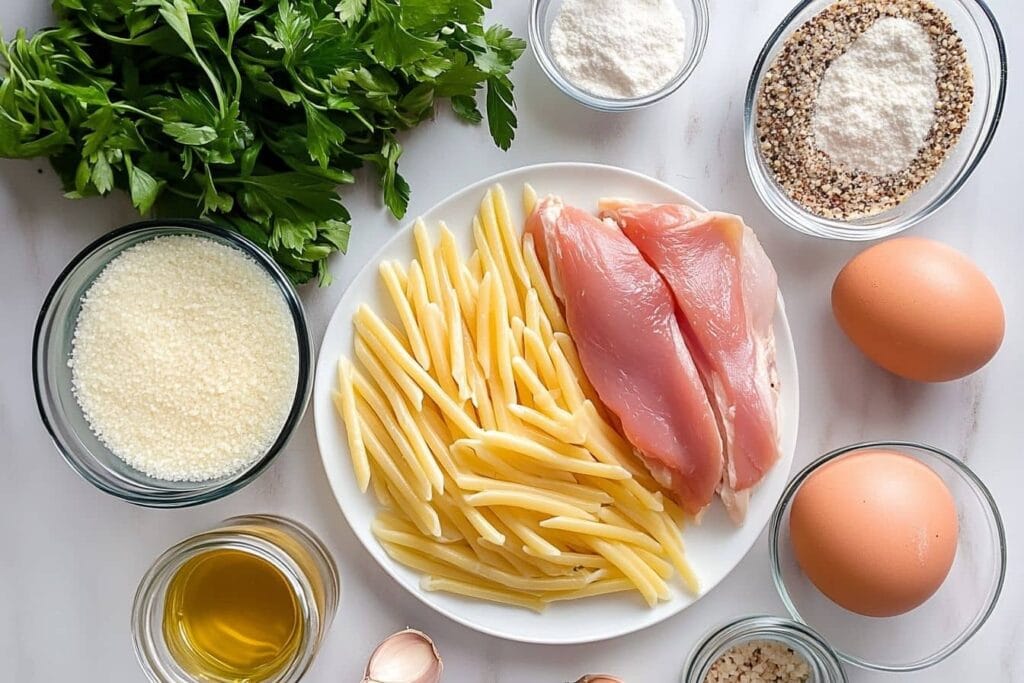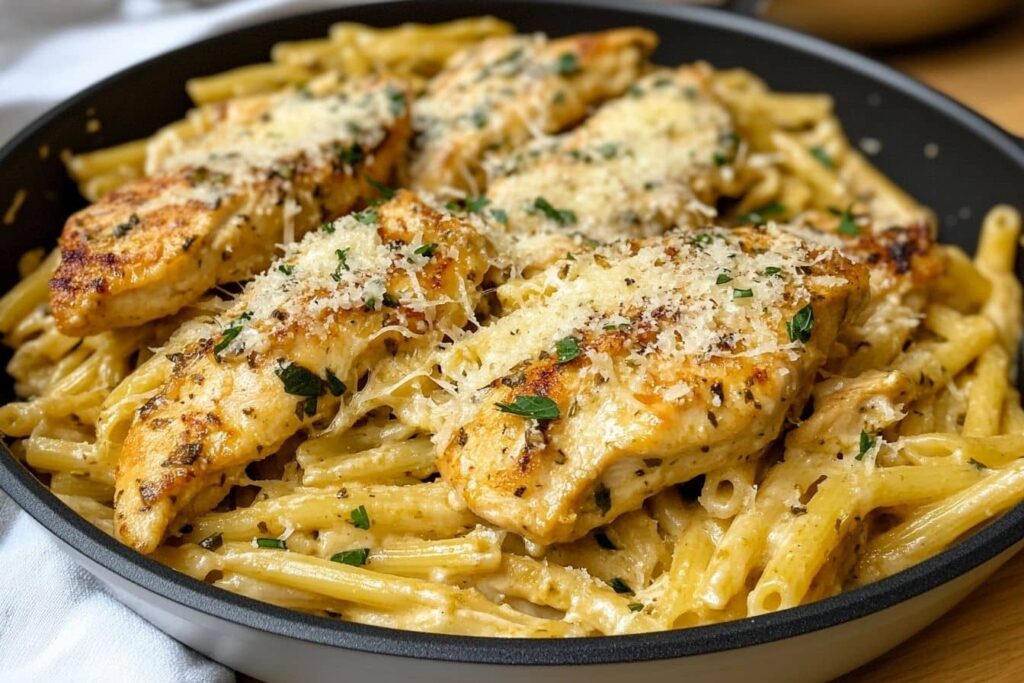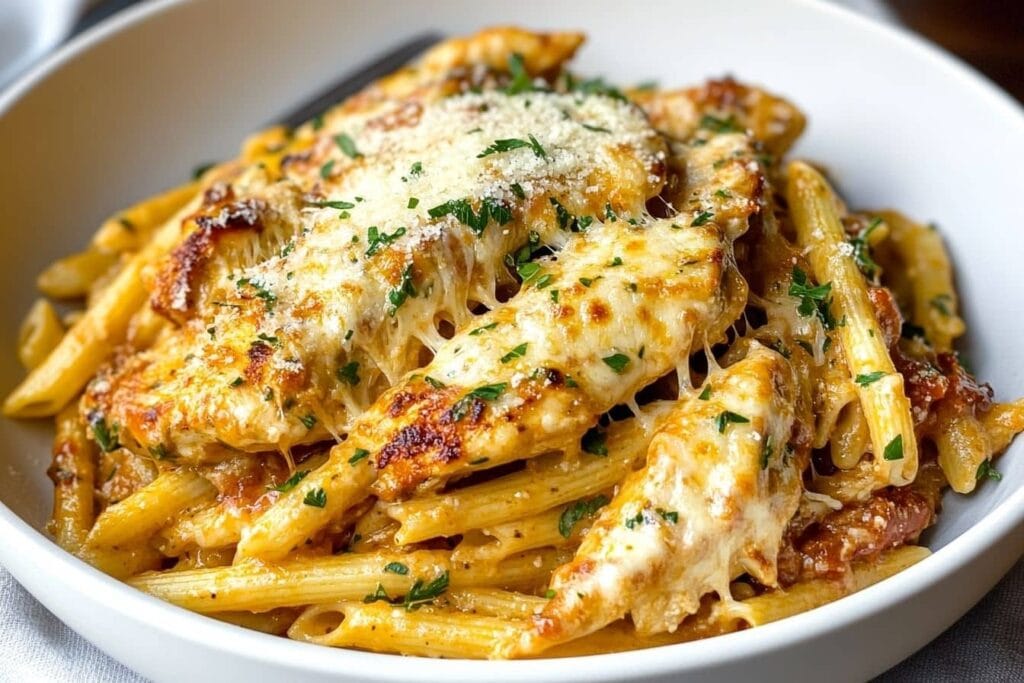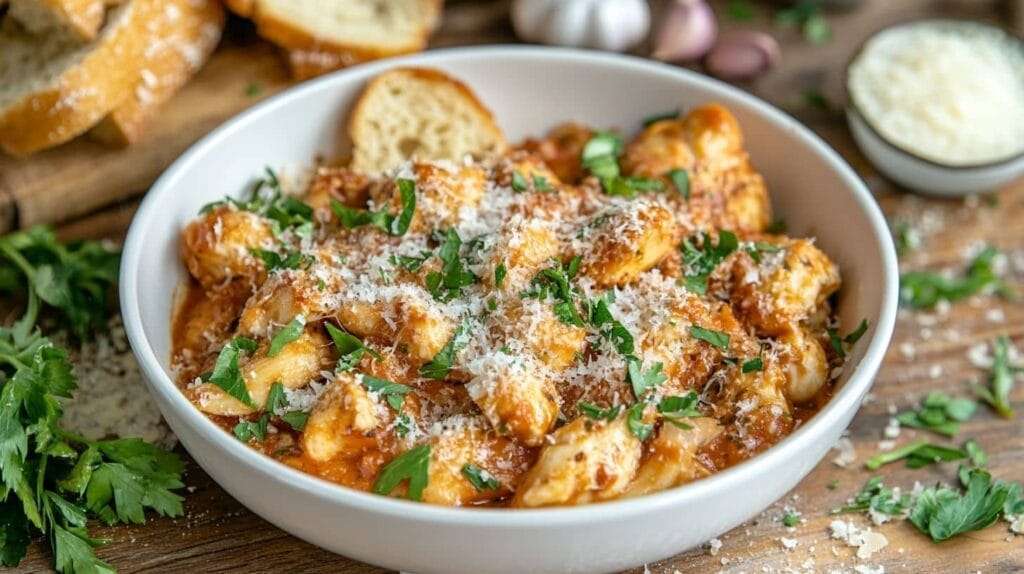This Garlic Parmesan Chicken Pasta is the ultimate comfort food, blending tender, juicy chicken with a creamy, garlicky Parmesan sauce that coats every strand of pasta in rich, cheesy goodness. It’s a restaurant-quality dish made easily in your own kitchen, perfect for busy weeknights or a cozy weekend dinner. With simple ingredients and an easy cooking process, this dish is bound to become a household favorite!
Why You’ll Love This Recipe
- Quick & Easy: Ready in under 30 minutes!
- Rich & Creamy: The perfect balance of garlic, Parmesan, and cream.
- Family Favorite: Loved by kids and adults alike.
- Versatile: Works with different pasta types and proteins.
Table of Contents
Ingredients for Garlic Parmesan Chicken Pasta

Ingredients Garlic Parmesan Chicken Pasta
(Full measurements are in the recipe card below.)
- Red Pepper Flakes (Optional): For a little heat.
- Chicken: Boneless, skinless chicken breast or thighs, cut into bite-sized pieces.
- Pasta: Any pasta works, but penne or fettuccine are great choices.
- Garlic: Freshly minced for the best flavor.
- Parmesan Cheese: Freshly grated for maximum meltability.
- Heavy Cream: Creates that rich, creamy texture.
- Butter: Adds depth and richness to the sauce.
- Chicken Broth: Helps balance out the creamy texture and infuses flavor.
- Olive Oil: For searing the chicken.
- Italian Seasoning: A blend of herbs to enhance the flavor.
- Salt & Pepper: Essential seasonings.

How to Make Garlic Parmesan Chicken Pasta
1. Cook the Pasta
Bring a large pot of salted water to a boil and cook the pasta according to package instructions until al dente. Reserve ½ cup of pasta water before draining.
2. Sear the Chicken
Heat olive oil in a large skillet over medium-high heat. Season the chicken pieces with salt, pepper, and Italian seasoning. Sear them until golden brown and fully cooked. Remove from the pan and set aside.
3. Make the Garlic Parmesan Sauce
In the same pan, melt butter over medium heat. Add the minced garlic and cook until fragrant. Pour in the chicken broth and heavy cream, stirring to combine. Let it simmer for a few minutes.
4. Add the Cheese & Pasta
Stir in the grated Parmesan cheese until melted and smooth. Add the cooked pasta and chicken back into the pan, tossing everything together. If needed, use some reserved pasta water to loosen the sauce.
5. Serve & Enjoy
Garnish with extra Parmesan and a sprinkle of red pepper flakes if desired. Serve warm and enjoy!
Pro Tips for Making Garlic Parmesan Chicken Pasta
- Use Fresh Parmesan: Pre-shredded cheese doesn’t melt as well.
- Don’t Overcook the Chicken: Keep it juicy by cooking just until done.
- Reserve Pasta Water: It helps to thin the sauce while keeping it creamy.
- Let the Sauce Simmer: This develops a rich, flavorful texture.
How to Serve Garlic Parmesan Chicken Pasta
- With Garlic Bread: A crispy side to soak up the sauce.
- With a Side Salad: A fresh, crunchy contrast to the creamy pasta.
- With Roasted Veggies: Broccoli, asparagus, or zucchini pair well.
Make Ahead and Storage
- Make Ahead: Cook the pasta and chicken separately and store in the fridge for easy assembly.
- Storage: Store leftovers in an airtight container in the fridge for up to 3 days.
- Reheating: Warm on the stovetop with a splash of cream or milk to revive the sauce.
- Freezing: This dish isn’t ideal for freezing due to the creamy sauce separating.

FAQs Garlic Parmesan Chicken Pasta
Can I use milk instead of heavy cream?
Yes, but the sauce will be thinner. Try mixing in a bit of cream cheese for extra richness.
What pasta works best for this dish?
Penne, fettuccine, or rigatoni work well since they hold onto the creamy sauce.
Can I make it spicy?
Absolutely! Add more red pepper flakes or a dash of hot sauce.
How can I make this dish lighter?
Swap the heavy cream for half-and-half and use grilled chicken instead of pan-seared.
This Garlic Parmesan Chicken Pasta recipe is a must-try for anyone who loves a rich, creamy, and flavorful dish that comes together effortlessly. Whether you’re making it for a quick weeknight dinner or serving it for a special occasion, it’s guaranteed to impress. With its velvety sauce, juicy chicken, and perfectly cooked pasta, this dish delivers pure comfort in every bite. Give it a try and watch it become a new favorite in your kitchen!
You might also like these
- Easy Jello Glow Cheesecake Recipe

- Cheesesteak on Garlic Parmesan Bread

- Hawaiian Punch Pound Cake

- Stuffed Seafood Bread Bowl Recipe

- Golden Sweet Cornbread Recipe

- Pineapple Strawberry Pound Cake

- Creamy Greek Yogurt Dressing

- Cinnamon Sore Throat Tea Recipe

- Neon Blast Jolly Rancher Candy Apples

- Creamy Crab and Shrimp Seafood Bisque Recipe

- Creamy Crab and Shrimp Seafood Bisque

- Paula Deen’s 5 Minute Fudge Recipe


